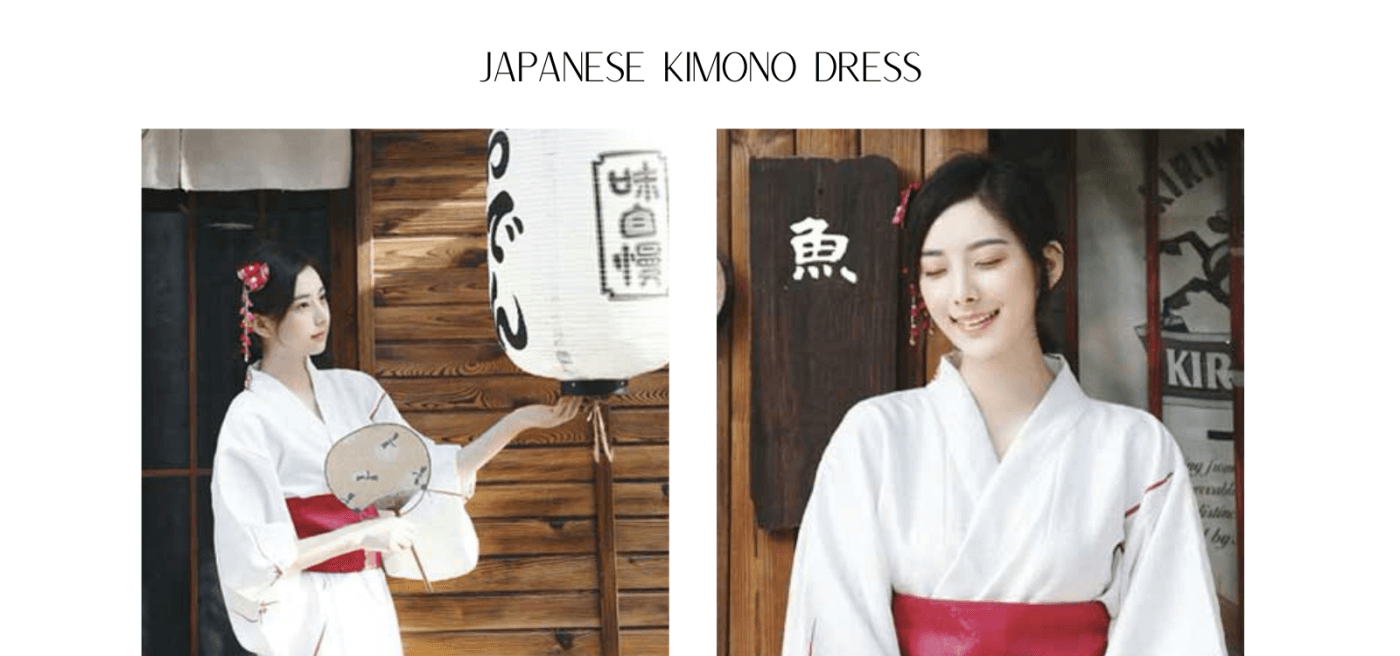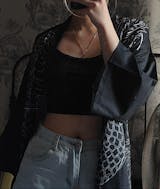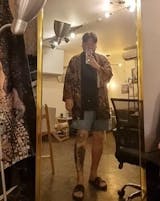Kimono Dress
The Japanese kimono dress has become a global fashion icon thanks to its timeless beauty and one-of-a-kind style. Today, this traditional garment implements modern twists while retaining its rich history.
Read on to learn all you need to know about kimono dresses, from what they are and how they are made to the events they are worn to.
What Is a Japanese Kimono Dress?

The kimono or gofuku is a traditional Japanese outfit designed with long sleeves and a length that goes from one’s shoulders down to their heels.
Modern kimonos can trace their origin to garments worn during the Wu dynasty in China. As rulers changed, so did the garment. This evolution led to the introduction of unique styles of layering silk robes in Japan, creating the kimono we know today.
How Are Kimono Dresses Made?
Makers of the kimono dress use several handmade and hand-decorated fabric called tans that they typically sew into a "T" shape along straight seams. They attach a collar to create a clean shape around the wearer's neck.
Traditionally, these fabrics consisted of silk, linen, and hemp. However, modern kimonos use cotton and polyester.
The wearer’s size doesn't determine the fabric's cut. Instead, the fabric is folded and draped around the wearer’s covered body and tied with an obi belt.
The fabric's width and floor length will determine the kimono's size. A standard kimono dress utilizes materials with a width of 14 inches. However, plus sizes may require wider fabrics.
The thread, weave, and the dye will determine the kimono’s weight, durability, surface, and drape. While you can use the same fabric to create kimonos for men and women, feminine kimonos feature elaborate dye, embroidery, and pattern details.
What Does a Kimono Symbolize?
$104.90
This Kimono doesn't include the obi belt, geta, or underwear.
DETAILS
Kimono
Full Sleeve
Floral print
COMPOSITION
Cotton
S (5"- 5"4 / 155-165 cm) M (5"5- 5"6 / 165 cm) L (5"7 & above / 170cm)
… read moreJapanese Kimono Dress

On top of their stunning designs, many also value kimonos for their symbolism. Different sizes, styles, colors, motifs, and materials had different meanings.
Here are some of the ways people used a kimono’s style, material, color, or motif to recognize the wearer’s standing or personality:
- Style: Unmarried Japanese women and girls would wear a kimono with swinging sleeves, also known as a furisode, to formal events and special occasions.
- Color: A kimono's color was believed to carry the spirit of the plants the dye was extracted from. For instance, since blue was derived from indigo, which people used to treat stings and bites, many believed wearing blue would repel insects and snakes.
- Motif: The garment’s patterns and symbols were used to relay the wearer’s virtues, personality traits, and status.
- Material: Though most kimonos are made of silk, high-quality materials were often reserved for specific times and special events like a wedding.
Is It Rude to Wear a Kimono If You’re Not Japanese?
Given its historical and cultural significance, many might wonder if it is rude to wear kimonos or a yukata if you aren’t Japanese. Fortunately, the Japanese people see no insult in foreigners wearing this clothing.
In fact, there are several places where you can buy or even rent a kimono dress in Japan.
Kyoto has the highest number of yukata and kimono rental shops in Japan. The shops even provide you with an expert who’ll guide you on the right way to wear your kimono.
When and Where Do You Wear a Kimono Dress?
You can wear a kimono dress anywhere and at any time. However, there is a different kimono for each occasion and season. The kimono’s material, pattern, color, and design will determine these differences.
For instance, there are kimono dresses for everyday life that feature simpler patterns and utilize cheaper fabric than those meant for formal occasions or a special evening in town.
In addition, you could match your kimono with seasons, such as:
- Summer: This season is perfect for kimonos made from thin silk, which is ideal for the hot summer weather. They often feature bright and playful patterns of cherry blossoms.
- Autumn: Consider kimonos with exciting hues that match this season’s vibrant scenery.
- Winter: Kimono dresses for this season typically have an extra layer of cotton sewn between two silk layers, and the bottom touches the ground.
What You Require to Wear a Kimono Dress
Besides the kimono itself, a person needs to wear several other types of clothing when wearing their outfit. These clothing pieces you should order include:
- Susoyoke and hadajuban: These are kimono-specific articles of clothing women wear under their kimono. The susoyoke resembles a slip, while the hadajuban resembles a thin camisole.
- Nagajuban: This is a thin silk robe that is slightly shorter than your kimono.
- Koshi-himo: Koshi-himo are simple and inexpensive cotton sashes that you will use to tie the nagajuban.
- Obi: An obi is a larger outer belt worn on your waist that holds your kimono in place. It comes in various styles and patterns and, besides jewelry, is often your kimono’s primary accessory.
- Date-jime: The date-jime is a sash that secures your nagajuban and ties the kimono to your body.
- Tabi: These are ankle-high, split-toed socks meant to be worn with traditional Japanese footwear.
- Zori and geta: Zori and geta are traditional Japanese sandals.
How to Wear Your Kimono
Wearing a kimono is often challenging, especially if you’ve never worn one before. Fortunately, there are steps you can follow to make the process easier.
When wearing your yukata or kimono dress:
- Start by putting on your tabi: Wearing your tabi socks can be tricky after you’ve put on your kimono. However, making this the first step resolves those challenges.
- Wear the undergarments: Next, put on your susoyoke and hadajuban, ensuring you are covered underneath.
- Wear the nagajuban: Center the nagajuban on your body and use a koshi-himo to tie the garment just underneath your bust.
- Wear the kimono: Center the kimono, then wrap it around your legs, pulling its left edge to your body’s right side. After, wrap the kimono’s right side to your left.
- Tie the kimono: With everything required in place, tie your kimono over your waist using the other koshi-himo.
- Arrange the collars: Adjust the collars to ensure they are symmetrical, leaving about two centimeters of your nagajuban collar showing.
- Put on your obi: Finally, complete the look by putting on your obi belt.
When putting on your kimono, pay attention to how you wrap the collars. It's important to ensure you wrap the kimono’s left side over the right.
What Do Japanese Wear Under Kimono Dresses?
When wearing their kimono dresses, Japanese women always wear a hadajuban and susoyoke directly on their naked skin. While today most women will wear their kimonos with undergarments, traditionally, this was not the case.
Modern Kimono Sleeve Dress
The modern kimono has evolved in terms of fabric, style, and wearability. While the traditional garment ican be challenging, newer versions implement designs that make them easy to put on.
Also, by minimizing the number of layers, modern kimono sleeve dresses don’t cost as much and allow you to move easily.
At Eiyo Kimono, we provide an extensive selection of kimono dresses for men and women that implement these modern designs without sacrificing the garment’s rich history. From kimono wraps to kimono maxi dresses, we have kimonos perfect for any event.
Browse through our extensive kimono dress catalog and order yours today.






